|
|
ARTHROPODS:
Insects»
Spiders»
Centipedes»
Millipedes»
Sowbugs»
Harvestmen»
Mites
& Ticks»
Scorpions»
Identification
Tips»
About
the Critter Files»
Links» |
|
|
|
KENTUCKY
CENTIPEDES
Critter
Files/Centipedes
By Blake Newton
University of Kentucky, Department of Entomology
| Common
Kentucky Centipedes: |
|
|
|
|
|
|
|
|
|
|
|
|
|
|
|
|
|
| |
| TAXONOMY |
KINGDOM: Animalia
| PHYLUM: Arthropoda | CLASS: Chilopoda (Centipedes)
ORDERS: Scutigeromorpha, Lithobiomorpha, Scolopendromorpha, Geophilomorpha,
and others |
| |
WHAT
IS A CENTIPEDE?
LIFE CYCLE
ECOLOGY
PEST STATUS
COMMON KENTUCKY CENTIPEDES
COLLECTING & PHOTOGRAPHY
CENTIPEDE FACTS
MYTHS, LEGENDS, AND FOLKLORE |
| |
| WHAT
IS A CENTIPEDE? |
|
Centipedes are long,
multi-segmented arthropods that resemble millipedes.
Centipedes have only 1 pair of legs on each segment, while
millipedes have 2 legs on most segments. Centipedes also resemble
insects, but insects
have only 3 body segments and 6 legs. Centipedes have 1 pair
of antennae, and chewing mouthparts. Centipedes are unique
because their first pair of legs have evolved into venomous fangs.
|
|
| SIZE:
Body length up to about 4" (10 cm) for Kentucky centipedes |
| |
| LIFE
CYCLE |
|
Centipedes have incomplete
metamorphosis: young centipedes hatch from eggs and look like small
adults. Centipedes shed their skin (a process called "molting")
as they grow into adults. Some species add legs each time they molt.
|
| |
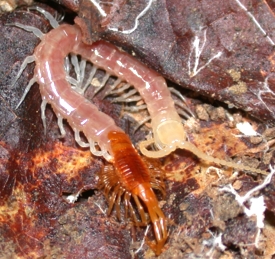 Scolopendromorph
centipede in the process of molting (B. Newton, 2005)
Scolopendromorph
centipede in the process of molting (B. Newton, 2005) |
| |
| Pictured
below are immature house centipedes (called "nymphs"). Each time a centipede (or any arthropod) molts, it enters a new life-stage, or "instar." The one on the top is very young (2nd instar), while the one of the bottom is a little older (4th instar).
Note that the nymphs have only 5 (younger) and 9 (older) pairs of legs, while the adult
house centipede (pictured in the Common Kentucky Centipedes section below) has 15 pairs. |
| |
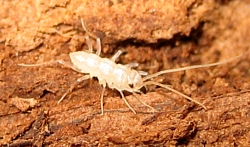 2nd Instar
Centipede Nymph: 5 pairs of legs (B. Newton, 2011)
2nd Instar
Centipede Nymph: 5 pairs of legs (B. Newton, 2011) |
| |
 4th Instar House
Centipede Nymph: 9 pairs of legs (B. Newton, 2004)
4th Instar House
Centipede Nymph: 9 pairs of legs (B. Newton, 2004) |
| |
| ECOLOGY |
|
Most centipedes live
underneath rocks, fallen logs, and in soil and leaf litter. Centipedes are primarily carnivorous, and they
feed on crickets, worms, termites, ants, and other small creatures. Centipedes
use their venomous front legs to capture and paralyze their prey.
Most centipedes hunt at night and hide during the day. Centipedes
are sometimes eaten (especially when they are young) by spiders,
predatory insects, other centipedes, and insectivorous mammals and
birds. |
| |
| PEST
STATUS |
|
| Centipedes are predators,
so they are not pests of crops, garden plants, or stored food. Sometimes,
though, they get into homes, where their frightening appearance and
painful bites can occasionally cause problems. Centipedes in
Kentucky and surrounding states are not dangerous unless a bite victim
has an allergic reaction to the bite ( a potential problem with any
biting or stinging insect or insect relative). Centipede bites are very rare in
Kentucky, and dangerous side reactions are rarer still. A few species of large tropical centipedes native to South
America, Asia, and elsewhere are considered to have very dangerous bites, however. |
| |
| COMMON
KENTUCKY CENTIPEDES |
| |
SCOLOPENDROMORPH
CENTIPEDES
ORDER: Scolopendromorpha
Other than the house centipede, the most familiar
centipedes in Kentucky may be the Scolopendromorphs
(order Scolopendromorpha). Full-grown scolopendromorph centipedes
have more than 21 or 23 pairs of legs. Pictured below are
some common scolopendromorphs. |
| |
Hemiscolopendra
marginata
ORDER: Scolopendromorpha
| FAMILY: Scolopendridae | GENUS and SPECIES: Hemiscolopendra
marginata
Hemiscolopendra marginata
is probably the largest centipede found in Kentucky.
It can reach 3". They are commonly found under logs and
loose bark. |
| |
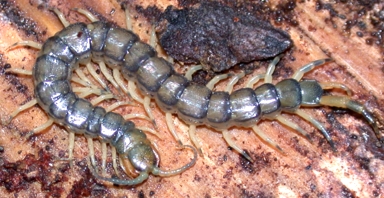 Hemiscolopendra
marginata (B. Newton, 2004)
Hemiscolopendra
marginata (B. Newton, 2004)
|
|
| |
Scolopocryptops
sexspinosus
ORDER: Scolopendromorpha
| FAMILY: Scolopocryptopidae | GENUS and SPECIES: Scolopocryptops
sexspinosus
Scolopocryptops sexspinosus
is common under rocks, logs, and loose bark in Kentucky. This
vivid red-orange centipede can reach 2-3". The molting
centipede pictured in the Life Cycle section above is also probably S.
sexspinosus. And visit this Bugguide link to see an incredible image of S. sexspinosus guarding a clutch of eggs. |
| |
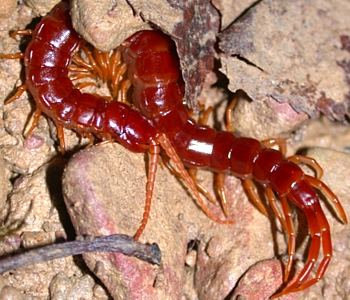 Scolopocryptops
sexspinosus (B. Newton, 2003)
Scolopocryptops
sexspinosus (B. Newton, 2003) |
|
|
STONE
CENTIPEDES
ORDER: Lithobiomorpha |
|
| Like scolopendromorphs,
Stone Centipedes (Order Lithobiomorhpa) are often
found under logs and rocks. They are usually shorter than scolopendromorphs,
with 15 pairs of legs. The stone centipede pictured below was
about 1.5 inches long and belongs to the Lithobius genus. |
| |
 Stone
Centipede (B. Newton, 2004)
Stone
Centipede (B. Newton, 2004) |
|
|
|
HOUSE
CENTIPEDES
ORDER: Scutigeramorpha | FAMILY: Scutigeridae | GENUS
and SPECIES: Scutigera coleoptera |
|
| House
Centipedes (Scutigera coleoptera) have very long legs, and are often seen running (quickly)
in basements and attics and other cool, indoor places. These
centipedes hunt crickets, ants, roaches, sowbugs, and other small creatures.
House centipedes are one of the few types of centipedes that
are not commonly found underneath rocks and logs. The house
centipede is probably not native to Kentucky. It is believed to be native to the Mediterranean region in Europe and has come to our part of the country from
further south. A house centipede nymph
is pictured above in the Life Cycle section. |
| |
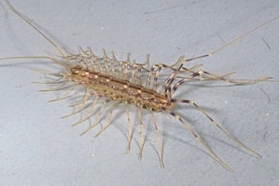 House
Centipede (R. Bessin, 2000)
House
Centipede (R. Bessin, 2000) |
| |
 House
Centipede, close-up (Photo Whitney Cranshaw, Colorado State University, courtesy Bugwood network)
House
Centipede, close-up (Photo Whitney Cranshaw, Colorado State University, courtesy Bugwood network) |
|
|
|
SOIL CENTIPEDES
ORDER: Geophilomorpha |
|
| Not pictured here are the Soil Centipedes, members of the centipede order Geophilomorpha. These small centipedes are very common in Kentucky, but difficult to photograph! See some examples at Bugguide. |
|
| |
| COLLECTING
& PHOTOGRAPHY |
|
Look for most centipedes
underneath logs, loose bark, rocks, mats of dead leaves, or inside
rotten wood. Scolopendromorph centipedes are especially common
underneath loose bark on fallen logs. House centipedes are
very common in many homes and buildings in Kentucky, especially in garages, sheds,
and similar locations. If you are interested in collecting
a centipede, never pick one up with your hands; instead, "herd"
it into a container with a stick or forceps. Centipedes are
best preserved in alcohol.
If you are brave (and
careful!) enough, you can try to keeping a centipede as a pet in
a small container. Provide a few inches of potting soil, and
some rocks or wood to hide under. The soil should be kept fairly
moist. Feed centipedes living insects or worms that are about
¼" the size of the centipede.
Centipedes also make
interesting photography subjects, but they are so fast-moving that
it can be hard to get a picture. Make sure to use a fast film
speed in bright light. Another trick: before a photo session,
cool down a centipede in a refrigerator for about 15 minutes. The
centipede will recover fully in a minute or so after it is removed
from the cold, but it will move slowly in the meantime - just enough
time for a few good pictures.
|
| |
| CENTIPEDE
FACTS |
|
Some centipedes are
incredibly large. Giant centipedes from South America will
grow to over a foot in length. For a large centipede like
this, insect aren't much of a meal: instead, prey include mice,
snakes, lizards, and frogs.
Centipedes have different
numbers of legs depending on the species. Although the species
with the most legs look impressive, the fastest centipedes are often
the ones with the fewest legs (such as house centipedes).
Centipedes and millipedes
are believed to be more closely related to insects than to spiders
and other arachnids.
For more information
about scolopendromorph centipedes, including the geographic ranges
for common species, visit the North Carolina Museum of Natural Sciences
website here. |
| |
| MYTHS
- LEGENDS - FOLKLORE |
|
It is often said that
centipedes have "100 legs." Although the word "centipede"
means "100 legs," centipedes usually have much fewer legs,
around 30-50. Some species of soil centipedes can have over
300 legs. |
|
| Centipedes are used as
ingredients in treatments for malaria and snakebites in some cultures.
|
|
| It is sometimes said that,
when cut in half, the two halves of a centipede will grow into two
separate centipedes. Although this is sometimes true for certain
worm species, it is not true for centipedes or millipedes (although
the two halves may wiggle and move for quite a while!). |
Original document: 25 May 2004
Last updated: 9 May 2011
The Kentucky Critter
Files are maintained by Blake Newton, Department of Entomology, University
of Kentucky.
Contact: blaken@uky.edu |
|

